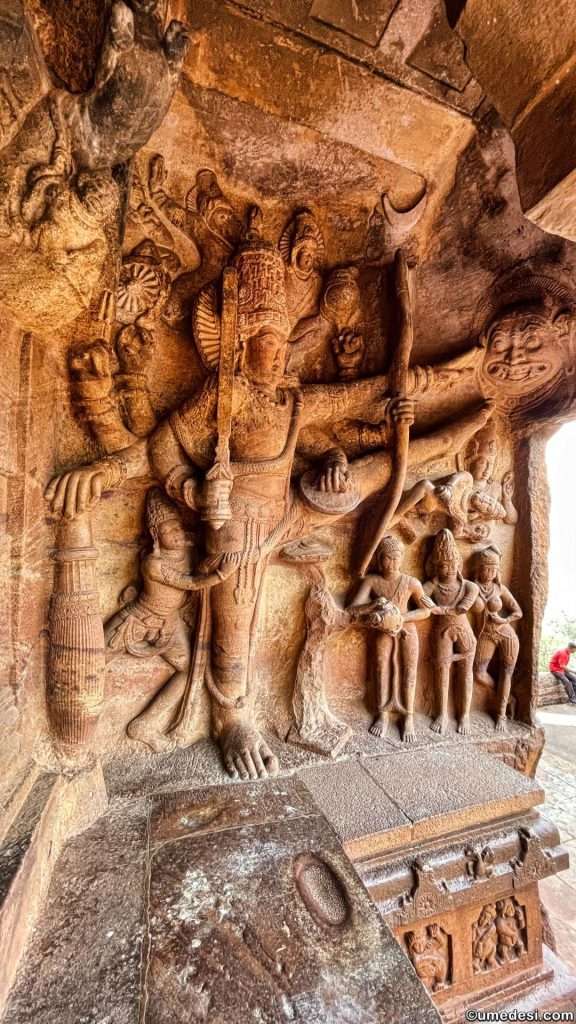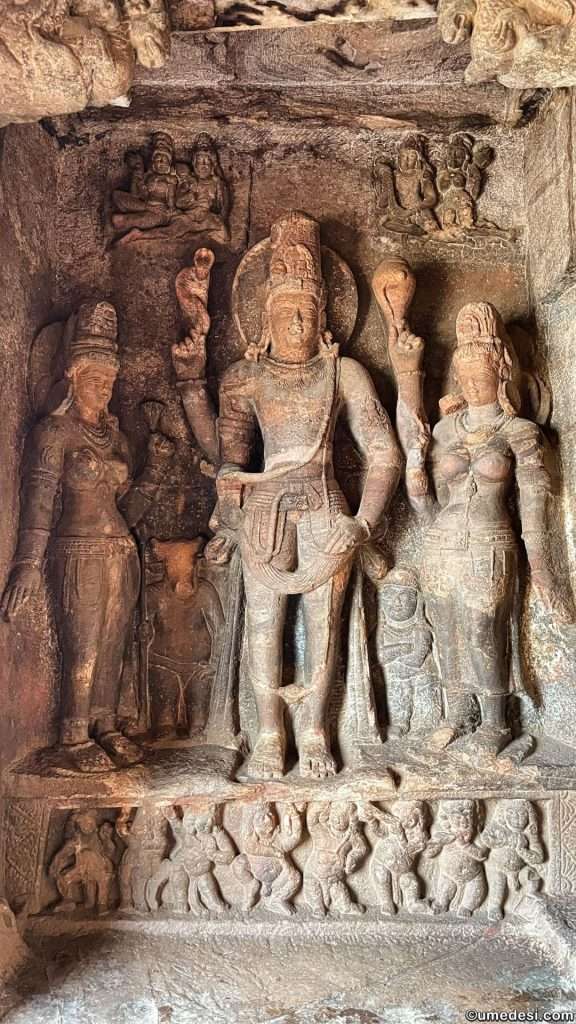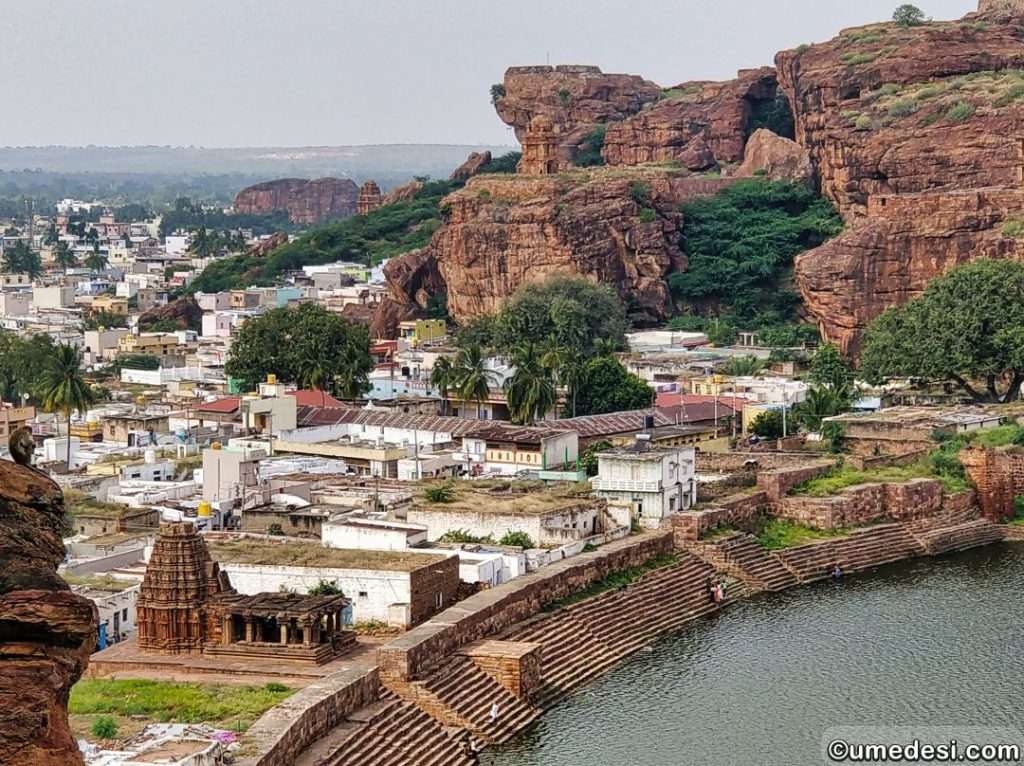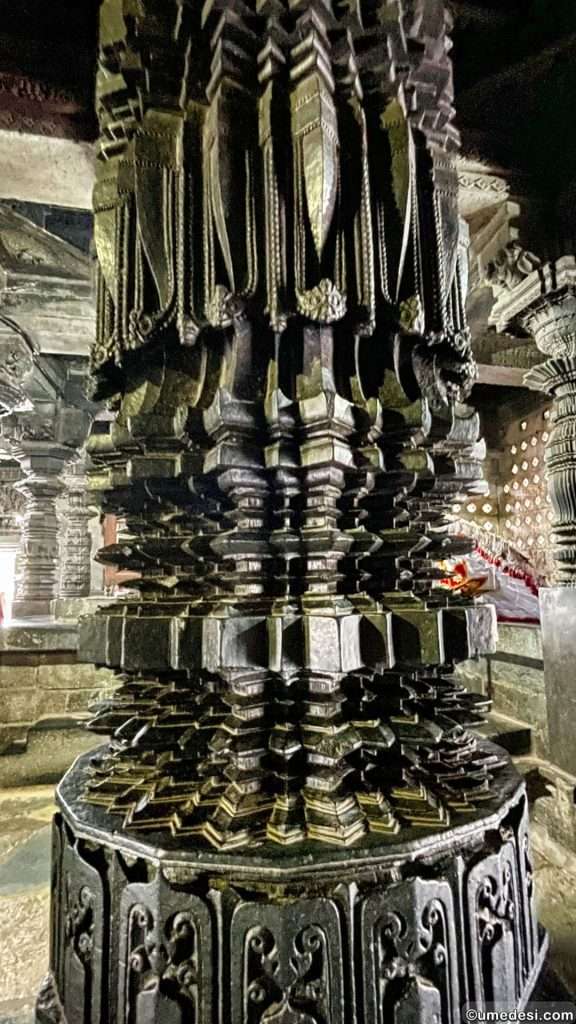By Desis, for Desis and Everyone Else!!
What’s a Desi?
The term “desi” is a term that is commonly used by people from the Indian subcontinent to refer to themselves or other people (origin or ancestry) from the region.
The word “Desi” is derived from the Sanskrit word “desh,” which means “country” or “region” or “homeland”. (‘Sanskrit’ word ‘Desh’? What is Sanskrit?)
Did you ever wonder:
What is Indian culture like? Learn more!
Interesting facts about India you didn’t know about!
Explore Indian customs.
Traveling to India? You are in for a treat – Explore here!
Here are a few articles from this site – use the menu at the very top of this page to discover many more…
Desi people can come from countries such as India, Pakistan, Bangladesh, Nepal, Sri Lanka, Bhutan, and Maldives. The term can also be used to describe aspects of Indian origin culture, including food, clothing, music, and art.
Badami Caves: Karnataka’s Rock-Cut Temples
Badami, an ancient city in Karnataka, India, is celebrated for its awe-inspiring cave temples and deep historical roots. Once the capital of the Chalukya dynasty, Badami stands as a testament to India’s artistic and architectural prowess. This article delves into the historical background, architectural marvels, and cultural significance of this heritage site.
Historical Background of Badami

Rise of Vatapi (Badami)
Founded in 540 CE by Pulakeshin I, Badami (formerly known as Vatapi) became the Chalukya dynasty’s capital, flourishing under the reign of Pulakeshin II (610–642 CE). Its strategic location, shielded by sandstone cliffs, provided natural fortification, fostering growth in art, architecture, and culture.
Key Historical Milestones
- 540 CE: Established by Pulakeshin I.
- 544 CE: Hill fortifications recorded.
- 610–642 CE: Pulakeshin II’s reign marked the zenith of the Chalukyan dynasty.
- Post-757 CE: Decline of Chalukyan dominance, but Badami retained its cultural importance.
The Badami Cave Temples

Carved between the 6th and 8th centuries CE, the Badami cave temples are masterpieces of Indian rock-cut architecture, blending artistry with spirituality.
Architectural Features
- Composed of soft Badami sandstone, allowing intricate carvings.
- Each cave includes an entrance verandah (mukha mantapa), a main hall (maha mantapa), and an inner sanctum (garbha griha).
- Fusion of Nagara (northern) and Dravidian (southern) architectural styles.
Cave Descriptions

- Cave 1:
Dedicated to Shiva, this cave features an 18-armed Nataraja depicted in 81 dance poses, a breathtaking illustration of artistic excellence. - Cave 2:
A Vaishnava cave adorned with sculptures of Vishnu’s avatars, including Trivikrama and Varaha, showcasing intricate mythological storytelling. - Cave 3:
The largest and most ornate, this cave celebrates Vishnu with exquisite carvings of Narasimha and Trivikrama. Its inscriptions shed light on Chalukyan achievements. - Cave 4:
Dedicated to Jainism, this cave houses serene sculptures of Tirthankaras, reflecting the era’s religious inclusivity.











Surrounding Temples and Structures in Badami
- Bhutanatha Temple:
Perched by Agastya Lake, this 7th-century Shiva temple is known for its serene setting and unique Dravidian architecture. - Upper Shivalaya Temple:
Located atop a hill, this temple features friezes depicting scenes from Krishna’s legends. - Malegatti Shivalaya:
An ancient Shiva temple known for its compact yet striking southern-style design. - Archaeological Museum:
This museum showcases artifacts from the Chalukyan era, offering insights into the region’s history.
Cultural and Historical Significance of Badami
1. Architectural Innovation
Badami served as a proving ground for early Indian rock-cut architectural techniques, influencing temple construction across the Deccan region.
2. Religious Harmony
The coexistence of Hindu and Jain cave temples highlights the era’s spirit of inclusivity and mutual respect among different faiths.
3. Artistic Excellence
Intricate carvings and sculptures demonstrate a high level of craftsmanship, preserving the artistic legacy of the Chalukyas.
4. Historical Documentation
Inscriptions within the caves provide valuable details about political events, cultural practices, and artistic achievements during the Chalukyan period.

Badami cave temples – Wikipedia
The Badami Circuit: A Cultural Triangle
Badami forms a part of a historical circuit that includes:
- Aihole (35 km): Known as the “Cradle of Indian Temple Architecture,” Aihole features over 120 temples showcasing architectural experimentation.
- Pattadakal (23 km): A UNESCO World Heritage site, Pattadakal is renowned for its blend of Nagara and Dravidian styles in monumental temples.
Together, these sites offer a comprehensive view of the evolution of Indian temple architecture.
Planning Your Visit to Badami
Getting There
- By Air: The nearest airport is in Hubballi, approximately 105 km away.
- By Train: Badami Railway Station connects to major cities in Karnataka.
- By Road: Accessible by buses and taxis from Bengaluru (450 km), Hubballi, and nearby historical sites.
Accommodation Options
- KSTDC Hotel Mayura Chalukya offers government-run hospitality.
- Private Hotels provide varied options for all budgets.
Best Time to Visit
The ideal time to visit Badami is from October to February, when the weather is pleasant for exploring.
FAQs About Badami Cave Temples
- Why is Badami historically significant?
It served as the capital of the Chalukya dynasty and played a pivotal role in developing Indian temple architecture. - What makes the cave temples unique?
The caves combine Nagara and Dravidian styles, feature intricate carvings, and represent both Hindu and Jain traditions. - What are the best nearby attractions?
Aihole and Pattadakal, part of the Badami circuit, offer unparalleled insights into early temple architecture. - Can I visit Badami in one day?
While it’s possible to cover major sites in a day, a two-day trip is recommended to fully appreciate the caves and surrounding temples.
Conclusion
Badami’s cave temples and surrounding monuments are a testament to the ingenuity, artistry, and cultural diversity of the Chalukya dynasty. This remarkable site continues to inspire visitors with its enduring legacy, providing a window into the richness of ancient Indian heritage.
Chennakesava Temple, Belur: A Star of Hoysala Architecture
Nestled in the tranquil town of Belur, Karnataka, the Chennakesava Temple stands as a crowning jewel of the Hoysala Empire. Built in 1258 CE under the patronage of King Narasimha III, this architectural marvel is dedicated to Lord Vishnu and showcases the pinnacle of medieval Indian craftsmanship. Its intricate carvings, star-shaped platform, and lifelike sculptures make it a timeless masterpiece of art and engineering.
Historical Significance: A Temple for the Ages
The Chennakesava Temple reflects the grandeur of the Hoysala period, a time when art, culture, and spirituality flourished. As one of the earliest temples to define the distinct Hoysala style, it represents the confluence of Nagara (North Indian) and Dravidian (South Indian) traditions, with innovative design elements that elevated temple architecture to new heights.
Built to commemorate the military victories of the Hoysalas and to honor Lord Vishnu, the temple became a center for devotion and artistic expression, inspiring subsequent temple construction across southern India.

Architectural Splendor: The Hallmarks of Hoysala Design
1. The Star-Shaped Platform
The temple is set on a multi-pointed star-shaped jagati (platform), a hallmark of Hoysala architecture. This unique design:
- Provides structural stability while enhancing visual symmetry.
- Facilitates pradakshina (circumambulation), allowing devotees to admire the intricate carvings on the walls.

2. Intricate Exterior Walls
The outer walls of the Chennakesava Temple are divided into horizontal bands, each narrating a distinct story or theme:
- Base Friezes: Rows of elephants, lions, and horses symbolizing strength, valor, and speed.
- Middle Section: Depicts Hindu deities, celestial beings, and mythical creatures, reflecting the spiritual richness of the time.
- Upper Section: Features floral scrolls, geometric patterns, and smaller motifs, adding an elegant touch to the temple’s façade.









Sculptural Brilliance: Stories Etched in Stone
The Chennakesava Temple is celebrated for its narrative friezes and lifelike sculptures that bring mythology and daily life to vivid life.
1. Narrative Panels
The temple walls narrate episodes from Hindu epics such as the Ramayana, Mahabharata, and Bhagavata Purana. Notable scenes include:
- The Kurukshetra War: Depicted with dynamic battle scenes and expressive figures.
- Rama’s Exile: Illustrates moments of devotion, conflict, and resolution with intricate detailing.

2. Everyday Life and Realism
Carvings of court life, musical performances, hunting expeditions, and family interactions provide a glimpse into the cultural vibrancy of the Hoysala period.

3. Madanikas: Dancing Beauties in Stone
The Madanikas (Shilabalikas), or bracket figures, are among the temple’s most iconic features. Mounted beneath the eaves, these sculptures:
- Depict celestial maidens in dynamic poses, such as Darpana Sundari (lady with a mirror) and Mango Plucking Madanika.
- Showcase unparalleled precision in carving ornaments, facial expressions, and attire.




The Pillars: Engineering and Artistic Marvels
The pillars inside the Chennakesava Temple exemplify a blend of technical precision and artistic creativity:
- Lathe-Turned Designs: Many pillars feature gear-like ridges and smooth, polished surfaces, achieved through advanced machining techniques that continue to baffle modern engineers.
- Narasimha Pillar: Known for its intricate carvings and rumored ability to rotate, it highlights the ingenuity of Hoysala architects.
- Gravity-Defying Pillar: A remarkable 42-foot pillar that appears to balance on a single point, raising questions about the mathematical precision of its design.



How complex is the art here?
The Chennakesava Temple stands as a marvel of artistic and architectural achievement, even when compared to global monuments of its time:
1. Intricacy vs. Gothic Cathedrals
While Notre-Dame de Paris is celebrated for its soaring heights and stained glass, the Chennakesava Temple surpasses it in sculptural density and narrative storytelling.
2. Storytelling vs. Angkor Wat
The bas-reliefs at Angkor Wat focus on grand epics but lack the variety and lifelike detailing of Chennakesava’s carvings, which capture mythology, nature, and daily life with equal precision.
3. Precision vs. Michelangelo’s David
While David showcases the Renaissance focus on human anatomy, the Madanikas of Chennakesava Temple combine emotional depth with intricate jewelry and cultural motifs, reflecting a richer narrative context.
Legacy and Significance
The Chennakesava Temple remains a cornerstone of Indian temple architecture, influencing later Hoysala monuments and enriching India’s cultural heritage. Its artistry and engineering highlight:
- Artistic Innovation: A shift from purely functional temple designs to narrative-rich sculptures.
- Cultural Identity: A visual repository of Hindu mythology and Hoysala culture.
- Global Recognition: Its inclusion as part of the UNESCO World Heritage tentative list underscores its significance.
Planning Your Visit to Chennakesava Temple
How to Reach:
- By Air: The nearest airport is Mysuru, 150 km away.
- By Train: Hassan Railway Station is 40 km from Belur.
- By Road: Belur is accessible by bus and taxi from Bengaluru (220 km) and Mysuru.
Best Time to Visit:
Visit between October and February for pleasant weather and optimal sightseeing conditions.
FAQs About Chennakesava Temple
- What makes the Chennakesava Temple unique?
Its intricate carvings, Madanikas, and star-shaped platform exemplify the peak of Hoysala craftsmanship. - How does it compare to other Hoysala temples?
While similar in style, its Madanikas and detailed narrative panels set it apart as a cultural and artistic jewel. - Are guided tours available?
Yes, local guides provide insights into the temple’s history, art, and architecture. - What festivals are celebrated here?
The annual Vairamudi Utsav, dedicated to Lord Vishnu, is a major event that attracts devotees and tourists.
Conclusion
The Chennakesava Temple is more than a monument; it is a celebration of art, culture, and spirituality. Its intricate carvings, narrative depth, and engineering brilliance stand as a testament to the creativity and devotion of the Hoysala Empire. Compared to global architectural marvels, it remains unmatched in its combination of aesthetic beauty and narrative richness, inviting visitors to marvel at its timeless elegance.
Intrigued by the artistic brilliance of the Chennakesava Temple? Explore its counterpart, the Hoysaleswara Temple in Halebidu, to uncover how the Hoysalas mastered Shaivite and Vaishnavite traditions in temple art and architecture.
Aihole Temple Complex: The Cradle of Hindu Temple Architecture
The Aihole temple complex in Karnataka, India, is a living chronicle of ancient India’s rich architectural legacy. Known as the “cradle of Hindu temple architecture,” Aihole offers an unparalleled glimpse into the evolution of temple design, blending artistry with spiritual grandeur.
Historical Background of Aihole
Prehistoric Roots
Aihole’s history dates back to prehistoric times, evidenced by artifacts and rock shelters that speak of millennia-old human habitation.
Golden Era Under the Chalukyas
Aihole rose to prominence in the 4th century CE, flourishing as a center of temple architecture under the Chalukya dynasty. Between the 6th and 12th centuries CE, it served as the Chalukya capital and attracted artisans, architects, and scholars who experimented with diverse temple styles. Most surviving monuments date to the 7th–10th centuries CE, showcasing a vibrant period of architectural innovation.
Architectural Marvels of Aihole
The Aihole complex spans over 5 square kilometers and boasts over 120 stone and cave temples, each a testament to creativity and experimentation.
Key Features
- Diverse Styles:
Aihole’s temples reflect Nagara (northern Indian), Dravida (southern Indian), and Vesara (a hybrid) styles, illustrating a blend of regional influences. - Experimental Layouts:
Temples vary in layout, including square, rectangular, circular, and apsidal (horseshoe-shaped) designs, echoing an experimental ethos. - Structural Innovations:
Unique features include mantapa (hall) designs, intricate pillar carvings, advanced window placements, and vaulted ceilings. - Sculptural Excellence:
The temples feature elaborate carvings of deities, mythological narratives, and scenes from daily life, displaying unparalleled craftsmanship.
Notable Temples in Aihole
1. Durga Temple
Despite its name, the Durga Temple is dedicated to Vishnu and Surya. Its apsidal design is inspired by Buddhist chaitya halls, and its carvings include intricate depictions of gods and mythological stories.
2. Lad Khan Temple
Among Aihole’s oldest structures, this temple started as a royal assembly hall before its conversion into a Shiva temple. Its simple yet robust design emphasizes functionality.
3. Meguti Jain Temple
This Jain temple, perched on a hill, stands out for its inscriptions and unique architectural elements, offering insights into Jain contributions to Aihole’s cultural mosaic.
4. Ravana Phadi Cave
A 6th-century rock-cut temple featuring striking depictions of Hindu deities like Shiva and Parvati, Ravana Phadi Cave showcases early examples of rock-cut artistry.
Significance of the Aihole Temple Complex
1. Architectural Laboratory
Aihole served as a testing ground where architects refined techniques that would shape temple architecture across India.
2. Religious Harmony
The coexistence of Hindu, Jain, and Buddhist structures highlights the era’s inclusive and tolerant ethos.
3. Historical Insight
Inscriptions and temple carvings provide invaluable glimpses into ancient India’s social, cultural, and political dynamics.
4. Artistic Legacy
Aihole’s sculptures represent a zenith in Indian art, blending realism with spiritual motifs.
5. Educational Value
As the “cradle of Hindu temple architecture,” Aihole is an open-air museum, offering lessons in the evolution of architectural styles.

Aihole – Wikipedia
Famous Jain Temples and Nearby Sites
If you’re exploring Aihole, consider visiting nearby architectural gems:
- Pattadakal: A UNESCO World Heritage site showcasing Chalukyan architecture with a blend of Nagara and Dravida styles.
- Badami: Known for its rock-cut caves and structural temples dedicated to Shiva, Vishnu, and Jain Tirthankaras.
- Mahakuta Temples: A serene cluster of temples known for their sacred tanks and unique carvings.
How to Appreciate Aihole’s Architectural Legacy
To fully experience Aihole’s treasures, visitors should:
- Explore Varied Designs: Notice the experimental layouts and structural innovations across different temples.
- Study the Sculptures: Appreciate the intricate carvings and their depiction of mythological and daily life scenes.
- Reflect on Religious Harmony: Observe the coexistence of Jain, Buddhist, and Hindu structures, symbolizing inclusivity.
- Consider Historical Context: Learn about the cultural and political backdrop that nurtured such creativity.
Planning Your Visit to Aihole
Getting There
- By Air: The nearest airport is in Hubli, about 120 km away.
- By Train: Badami is the closest railway station, located 35 km from Aihole.
- By Road: Aihole is well-connected to nearby cities like Badami and Pattadakal via regular buses and taxis.
Best Time to Visit
Visit between October and February for pleasant weather.
FAQs About Aihole Temple Complex
- Why is Aihole called the “cradle of Hindu temple architecture”?
Aihole served as a laboratory where temple designs were tested and refined, influencing temple architecture across India. - How many temples are in Aihole?
Aihole is home to over 120 temples, showcasing diverse styles and layouts. - What is the significance of the Durga Temple?
The Durga Temple is notable for its apsidal design and elaborate carvings, inspired by Buddhist chaitya halls. - Are there Jain temples in Aihole?
Yes, the Meguti Jain Temple is a prominent example of Jain architecture in Aihole. - What are other nearby attractions?
Pattadakal, Badami, and Mahakuta are must-visit sites that complement Aihole’s architectural legacy.
Conclusion
The Aihole temple complex is a timeless repository of ancient India’s architectural brilliance. Its experimental designs, intricate sculptures, and historical significance make it a must-visit destination for history enthusiasts, architecture lovers, and spiritual seekers alike.
The term Desi can refer to people of Indian subcontinent origin or ancestry, or it can refer to the cultural practices and products of the region.
Desi food, will include dishes such as biryani, Pongal, samosas, Dosa, Idli, Parantha, Chawal and dal, while Desi fashion may feature traditional clothing styles like sarees, salwar kameez, Dhoti, and kurta pajama.
Desi music may include traditional folk music (dozens of styles), classical music (also several distinct schools), traditional dance (several traditional and ancient styles) and popular movie or music genres like Bollywood, Tollywood, Kollywood, Mollywood (all different regional language film industry names – a play on the word Hollywood).
Use the Menu at the very top of this page to view many more articles.



